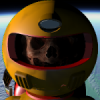The fractal map computed for quadtree node already contains 3 independent fractal noise channels. The first one computes elevation and is seeded from heightmap data. Other two are used for detail material mixing and other things. There is also a fourth channel containing global slope.
I modified the shader that computes vertex positions to displace also in horizontal directions, using one of the two independent fractal channels. Amount of displacement also varies with global slope - areas in flat regions are shifted minimally, but sloped parts that are also treated as rock are displaced a lot. This makes rocky parts much more interesting. For the record, the actual equation used for displacing point on a sphere in tangent space is this:

Next thing that had to be done was to compute the normals of such deformed surface. Article in GPU Gems about deformers provides nice info about Jacobian matrix that can be used for the job. After some pounding to my math circuits I managed to produce the following Jacobian of the above equation (in tangent space):

Normal is then computed as cross product between the second and third column, since the tangent and binormal are {0,1,0} and {0,0,1} respectively.
Finally, here is the result - left side original with only the vertical displacement, on the right side vertical&horizontal displacement:

There are still some issues but the overall effect is quite nice. Of course, collisions with sloped parts are no longer accurate and I'll have to do something with it later.




But indeed, how do you get these displacements "back" into your simulation model of the terrain for collision purposes is the real question. I'm curious to see your solution to this problem.